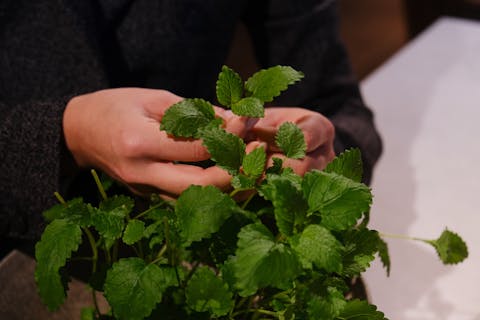Giulia Caffiero, from Sardinia to the top of world gastronomy | Olianas
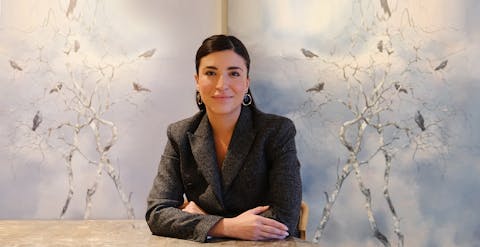
People
Giulia Caffiero, from Sardinia to the top of world gastronomy
by Jessica Cani
In Copenhagen, within the walls of the three-Michelin-starred restaurant Geranium—crowned the best in the world in 2022 by The World’s 50 Best Restaurants—there is a young woman from Sardinia redefining the boundaries of fine dining. Giulia Caffiero, Assistant Restaurant Manager at the renowned Danish venue led by Chef Rasmus Kofoed, embodies a new generation of hospitality professionals bringing a breath of innovation to the sector while staying true to their roots.
Her story begins like many others: a part-time job during university. “It was all very simple,” she recounts with the modesty of someone whose defining trait is determination. “I literally stumbled into this world thanks to Gianfranco Massa (one of the founders of Accademia Casa Puddu in Baradili), the uncle of a dear friend.” That first stumble led Caffiero to work at Cucina.eat, where she took her first steps in the restaurant world from scratch. “I couldn’t tell red wine from white,” she admits with a smile that conceals years of later study, “and the first time I held a plate, I dropped it.”
Those first three years were fundamental to her training. It was an intense learning period, where she absorbed not just the basics of service but also developed the sensitivity to hospitality that would shape her entire career. Her decision to move to Milan, where she worked alongside Marco Ambrosino at the restaurant 28 Posti and at Il Luogo di Aimo e Nadia, was not accidental—it was part of a deliberate growth journey. In the Lombard capital, she refined her skills in a more international context, dealing with a demanding and diverse clientele.
But in 2019, at the age of 27, Caffiero made a decision that would change the course of her professional life: moving abroad to improve her English. A choice that reveals much about her personality: rather than settling for a safe path, she chose to challenge herself. Copenhagen wasn’t a random choice. “I wanted a safe city, human-scale, not too far from home,” she explains. A thoughtful decision from someone who knows that growth requires calculated risks.
Her arrival at Geranium represents this blend of ambition and pragmatism. “I knocked on their door and told them I didn’t speak English but wanted to work there. They told me there was no room, but if I wanted, I could stay for two days and then leave,” she recalls. Despite the apparent rejection, she accepted. A bold move that many would consider reckless, but that actually showed a deep awareness of her potential. After just one service, they offered her a permanent contract—on one condition: learn English by Christmas. A challenge she embraced and won.
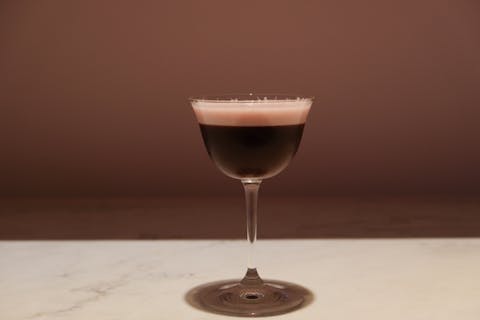
The juice pairing revolution at Geranium reflects Caffiero’s innovative approach to fine dining. It’s not merely about offering non-alcoholic alternatives to wine, but rather a sophisticated concept that applies the principles of food pairing—the science of matching ingredients based on their molecular and aromatic composition—to juices and natural beverages.
Her relationship with wine evolved honestly and naturally. “I’ve always loved this world,” she admits, “but over time I’ve met such well-prepared figures in the field, like my colleague Andrea Sala, head sommelier at Geranium, that I realized I could contribute more by focusing on something else.” It’s a rare self-awareness that pushed her not to settle, but to follow her own path. “I’m not the type to force something that doesn’t feel 100% mine,” she explains. “Wine is still a passion—I drink it, I can explain it—but I understood my road was another.”
The creative process behind Geranium’s juice pairing is a fascinating mix of technique and emotion. It starts in the Inspiration Kitchen, the experimental lab where she works when chef Rasmus Kofoed is not using it. “When the chef presents dishes to me, I taste them and a kind of natural mechanism triggers in my brain. Many of the juices I create are tied to memory,” she says. Her approach is almost synesthetic, where flavors evoke memories and sensations: “For example, a scallop might remind me of something Nordic, which in my mind translates immediately into berries.”
Behind this apparent spontaneity lies a methodical, rigorous process. “Sometimes I infuse herbs for a month,” she reveals, stressing how patience is essential. Seasonality plays a key role in every creation. Each juice pairing includes three core elements that reflect the time of year—though with a northern twist: “From December to February, nothing grows here but potatoes,” she explains. That’s why the team developed sophisticated preservation techniques.
The impact of this innovation is in the numbers: today, 30–40% of Geranium’s guests choose the juice pairing—an extraordinary result that proves this idea meets a real market demand. “There’s no precise age group,” she observes. “Some choose it at lunch, some are abstinent, others do it for religious or cultural reasons, or because they’re pregnant... The motivations are endless.”
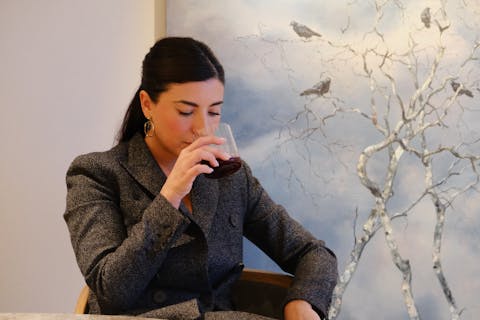
The success of juice pairing at Geranium led Caffiero to want to share her experience and knowledge with a wider audience. “The book, which is called Juice Pairing, was born almost spontaneously, as a response to a growing need for dissemination,” she explains. The project came to life thanks to the intuition of a friend who acted as a bridge to a publishing house, recognizing the innovative potential of her approach.
“I didn’t want to write a book to teach someone something,” she clarifies with the modesty that defines her. “The goal was rather to offer a bit of awareness, to show that creating something good isn’t as difficult as it seems.” This approach perfectly reflects her professional philosophy: democratizing excellence without compromising quality.
The book, more than a collection of recipes, is a journey through her creative method. It provides ideas and guidance for those who want to explore the world of juice pairing, sharing not only techniques but also the thought process behind a successful pairing. It’s a way of bringing the innovation of Nordic cuisine to a broader context, making it accessible even to the Italian audience.
This editorial project also represents an ideal bridge between her experience at Geranium and her desire to contribute to the evolution of contemporary dining. “I wanted to put on paper not just the recipes, but above all a vision,” she explains. A vision that speaks of sustainability, respect for the product, applied creativity, and a new way of thinking about pairings in fine dining.
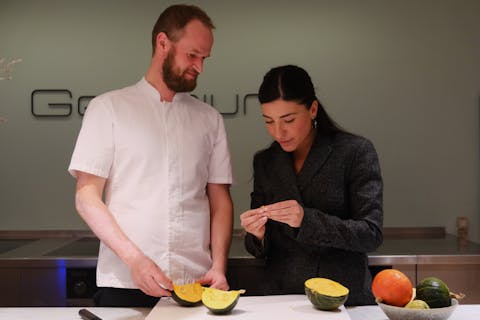
Sustainability at Geranium is a philosophy that permeates every aspect of daily work. “When we talk about sustainability in fine dining, we cannot focus solely on the final product; we must consider the entire ecosystem that produces it,” explains Caffiero. This approach is perfectly reflected in her work with juice pairing.
The choice of local and seasonal ingredients is not only a matter of taste but also a deliberate ethical stance. “In a climate like Denmark’s, where seasonality is extremely pronounced, we have had to develop innovative techniques to preserve and transform products.” This led to the creation of a complex preservation system that allows fruits, vegetables, and herbs to be used throughout the year, minimizing waste and maximizing the value of every ingredient.
Managing “waste” is another fundamental aspect of this philosophy. “In the Inspiration Kitchen, nothing goes to waste,” she emphasizes. Vegetable peels become broths, fruit scraps are transformed into jams and candies for the staff—every element finds a new life. This circular approach not only reduces environmental impact but also stimulates the team’s creativity.
Sustainability goes beyond raw material management. “We also work a lot on social sustainability,” she explains. “Attention to team management, work schedules, and staff well-being are factors that help create a truly sustainable environment.” This approach is reflected in the restaurant’s decision to move to a four-day workweek, showing that excellence can and should go hand in hand with respect for people.
Collaboration with local producers is another pillar of this vision. “When we source flowers and plants for the restaurant, we always prioritize local organic farms,” she says. “This not only ensures product freshness but also creates a direct connection with the territory and supports the local economy.” A virtuous circle demonstrating how sustainability can be a value multiplier for the entire community.
Juice pairing thus becomes not only an alternative to traditional wine pairings but also a manifesto of sustainability. “We use techniques such as fermentation, drying, and infusion to preserve the flavors of the seasons,” she explains. “This allows us to create complex and interesting beverages even in the winter months, when the availability of fresh produce is limited.” A concrete example of how innovation and sustainability can go hand in hand.
The decision to document these practices in her book also stems from a desire to spread this culture of sustainability. “It’s not just about sharing recipes, but about promoting a more conscious way of thinking about dining,” she states. “We want to show that it is possible to achieve excellence while respecting both the environment and people.”

As Assistant Restaurant Manager at Geranium, Giulia Caffiero oversees a team of 18 people in one of the most prestigious restaurants in the world—a position that requires a broad vision, strong leadership skills, and meticulous attention to detail. “I take care of everything,” she explains, “from seemingly simple things like ordering candles or napkins—we have ten different types with an exact count every week—to full team management and service organization.”
Her typical day is a constant flow of decisions and coordination. She also handles the restaurant’s floral arrangements, personally sourcing and selecting the flowers, which must be strictly organic. “If deliveries don’t arrive, I have to leave the restaurant and go to the farms,” she says, highlighting how her role demands total flexibility and dedication.
Managing an international team is perhaps the most stimulating challenge. In an environment where different cultures and approaches intersect, the ability to create harmony and motivation is essential. “You can’t just say ‘this is how I am’ when you work in an international environment,” Caffiero explains. “You have to be open to understanding cultures from around the world, to integrate into a type of community where everyone has their own personality, and we all make an effort to share and work together.”
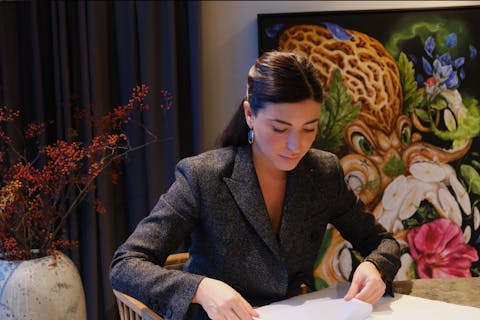
Despite her international career, Caffiero maintains a strong connection to her native Sardinia. She has always felt it, and over time that bond has remained solid. Among her favorite places on the island, she recommends Fradis Minoris in Nora or a simple pizza at Davide Bonu’s Impasto. Her journey is an example of how talent, determination, and openness to change can lead to excellence in contemporary dining.
Her ability to reinvent the concept of beverage-food pairing, taking juice pairing to world-class levels, demonstrates how innovation in hospitality can emerge from the perfect combination of technique, creativity, and sensitivity. Her success at Geranium is not only a story of personal achievement but also an example of how a new generation of Italian professionals is helping redefine the standards of gastronomic excellence globally.
From her first experiences in the world of wine to managing one of the most prestigious restaurants in the world, Caffiero’s path embodies the new face of international dining: young, innovative, sustainable, and respectful of tradition, while having the courage to reinvent it.
